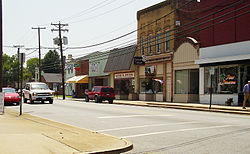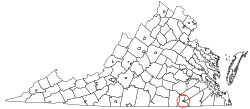History
Emporia has long been a transportation crossroads. The Meherrin River, like the Nottoway River and the Blackwater River, empties to the southeast into Albemarle Sound. The Town of Hicksford (originally Hicks' [7] Ford) was settled by Captain Robert Hicks (1658-1739) in the Virginia Colony, where the east-west Fort Road of eastern Virginia crossed the Meherrin River en route to Fort Christanna. The other crossing road was a major north–south trail used by native peoples and sometimes called the "Tuscarora Path" and later became the "Halifax road". [8]
Captain Hicks was an Indian trader who had lived in Prince George County before moving his family to Hicksford, when he became the Commander of Fort Christanna. (His surname is spelled both "Hicks" and "Hix" in colonial records.) In 1709, Hicks purchased a land tract of 1280 acres along the northside of the Meherrin River that was previously surveyed by Arthur Kavanaugh. [7]
When Greensville County separated from Brunswick County in 1781, Hicksford became the county seat. (Court convened monthly at a nearby tavern). In May 1781, British Col. Banastre Tarleton's cavalry crossed at Hicksford while raiding Greensville and Southampton counties. [9]
After statehood, the Virginia General Assembly recognized the Town of Belfield on the river's northern bank in 1798, and Hicksford on the southern bank the next year. [10]
In the following decades, the surrounding area remained rural and its population dispersed. Hicksford's population continued to exceed that of Belfield. An 1847 account documented 12-20 dwellings in Hicksford worth about $10,025 while Belfield's buildings were valued at $3050; in 1865 Hicksford's buildings were valued at $20,700 and Belfield's at $3650. However, by 1885, shortly before the towns merged, because of railroad links discussed below Hicksford had increased in assets only to $22,915 while Belfield had grown to $7300. [11]
By 1857, Belfield was a stop on the Petersburg Railroad to Weldon begun in 1830. During the American Civil War, the Petersburg Railroad became a tactical prize as Union troops sought to isolate the confederate capital. Two battles for the control of the Weldon Railroad were fought near Petersburg during the Siege of Petersburg in June 1864 and September 1864. Then on December 7, 1864, 28,000 Union troops led by Major General Gouverneur K. Warren tried to sever that key supply route further south by uprooting tracks, and managed to stop Confederate troops under Major General Wade Hampton from destroying the Meherrin River bridge. However, when the Federals retreated, Confederates rebuilt the railway line. [12] After the war, the Wilmington and Weldon Railroad was leased to the Wilmington, Columbia and Augusta Railroad. It went bankrupt in 1878.
Benjamin D. Tillar Jr. (1855-1887), a Greensville County native and state delegate, received a charter for the Atlantic and Danville Railway. He planned for it to go from Portsmouth as had the Weldon railroad, but with a more westward route through the Meherrin River towns. [13]
In 1887, Hicksford and Belfield merged, forming the newly incorporated town of Emporia. It was named after the town of Emporia, Kansas, home town of Tillar's friend U.S. Senator Preston B. Plumb of Kansas. However, the railroad boom proved short-lived, as poor farm conditions and the Panic of 1893 caused the county's population to decrease between 1880 and 1890. The Seaboard and Roanoke Railroad also ran through Emporia.
Emporia was re-chartered by the state in 1892. The town issued its first bonds in 1900 (to establish a water plant, and fund lighting and street improvements). It hosted an agricultural fair in 1906, and brick buildings replaced frame structures. Banks were chartered, followed by land improvement companies and insurance companies, then various stores, automobile companies and cola bottlers. [14]
The Virginia General Assembly re-chartered the Town of Emporia as an independent city in 1967, five years after the Norfolk and Western Railway purchased and reorganized the Atlantic and Danville Railway. Now, a major north–south CSX railway line crosses a Norfolk Southern east–west line in Emporia, the latter or which has been abandoned.
Also, U.S. Route 58 crosses Emporia east-west and Interstate 95 and U.S. Route 301 cross north–south. Emporia continues to serve travelers.
Historic buildings in Emporia include the Belfield-Emporia Historic District, Hicksford-Emporia Historic District, Greensville County Courthouse Complex, Greensville County Training School, H. T. Klugel Architectural Sheet Metal Work Building, Old Merchants and Farmers Bank Building, and Village View, all of which are listed on the National Register of Historic Places. [15]
Governance
Emporia was a Republican stronghold for many years after its founding and through the Reagan era. However, in the 1990s it began shifting toward the Democratic Party, with Bill Clinton carrying it by a majority for the first time in 1996. Since then, Emporia has voted consistently Democratic, with this party’s share of the vote increasing significantly under Barack Obama in 2008. In 2020, Joe Biden won over 67% of the vote, the strongest showing for a Democrat since the city was chartered.
The City of Emporia is governed by a council/manager system. There are seven members of city council elected from districts and a weak mayor elected at large. City council and the mayor are elected to four year terms, in federal election years. Their terms are staggered so that not all members are elected at once. [20]
The City of Emporia is also served by its own Treasurer, Commissioner of the Revenue, Sheriff and General Registrar. The courts system, Greensville County Sheriff, Commonwealth's Attorney and the Public Schools are shared with Greensville County.
Demographics
Historical population| Census | Pop. | Note | %± |
|---|
| 1890 | 1,088 | | — |
|---|
| 1900 | 1,027 | | −5.6% |
|---|
| 1910 | 2,018 | | 96.5% |
|---|
| 1920 | 1,869 | | −7.4% |
|---|
| 1930 | 2,144 | | 14.7% |
|---|
| 1940 | 2,735 | | 27.6% |
|---|
| 1950 | 5,664 | | 107.1% |
|---|
| 1960 | 5,535 | | −2.3% |
|---|
| 1970 | 5,300 | | −4.2% |
|---|
| 1980 | 4,840 | | −8.7% |
|---|
| 1990 | 5,306 | | 9.6% |
|---|
| 2000 | 5,665 | | 6.8% |
|---|
| 2010 | 5,927 | | 4.6% |
|---|
| 2020 | 5,766 | | −2.7% |
|---|
|
2010 census
As of the 2010 United States census, there were 5,927 people living in the city. 62.5% were Black or African American, 32.7% White, 0.7% Asian, 0.3% Native American, 0.1% Pacific Islander, 2.1% of some other race and 1.5% of two or more races. 4.4% were Hispanic or Latino (of any race).
As of the census [27] of 2000, there were 5,665 people, 2,226 households, and 1,406 families living in the city. The population density was 821.9 people per square mile (317.3 people/km2). There were 2,412 housing units at an average density of 349.9 units per square mile (135.1 units/km2). The racial makeup of the city was 56.15% Black or African American, 42.45% White, 0.07% Native American, 0.53% Asian, 0.07% Pacific Islander, 0.30% from other races, and 0.42% from two or more races. 1.48% of the population were Hispanic or Latino of any race.
There were 2,226 households, out of which 29.2% had children under the age of 18 living with them, 37.5% were married couples living together, 21.0% had a female householder with no husband present, and 36.8% were non-families. 32.2% of all households were made up of individuals, and 17.4% had someone living alone who was 65 years of age or older. The average household size was 2.43 and the average family size was 3.05.
By percentage of counties or independent cities, Emporia has the highest population of Muslims in the United States as of the 2010 census, with 28.99% of the independent city being adhering Muslims. [28]
In the city, the population was spread out, with 25.2% under the age of 18, 8.1% from 18 to 24, 25.6% from 25 to 44, 20.6% from 45 to 64, and 20.6% who were 65 years of age or older. The median age was 39 years. For every 100 females, there were 83.4 males. For every 100 females age 18 and over, there were 78.1 males.
The median income for a household in the city was $30,333, and the median income for a family was $35,743. Males had a median income of $27,772 versus $21,657 for females. The per capita income for the city was $15,377. About 11.4% of families and 16.0% of the population were below the poverty line, including 21.5% of those under age 18 and 14.5% of those age 65 or over.


